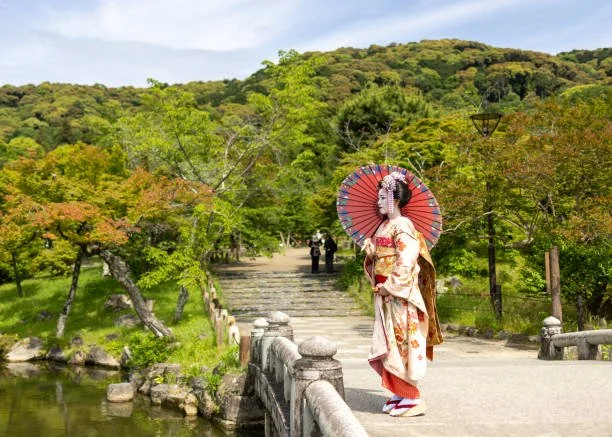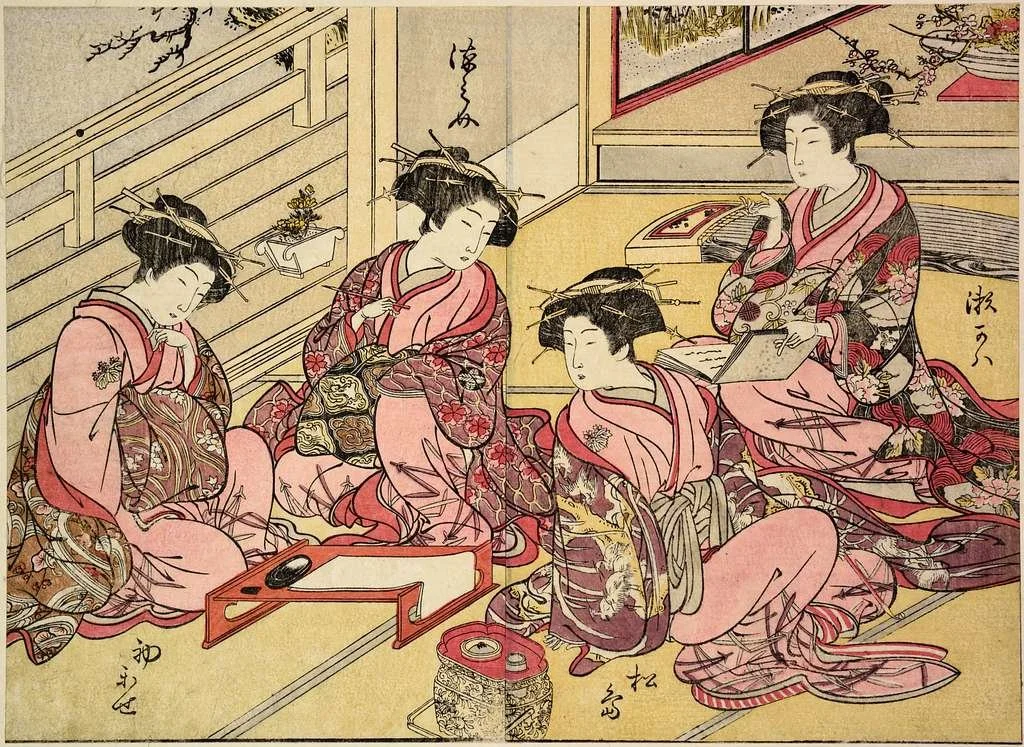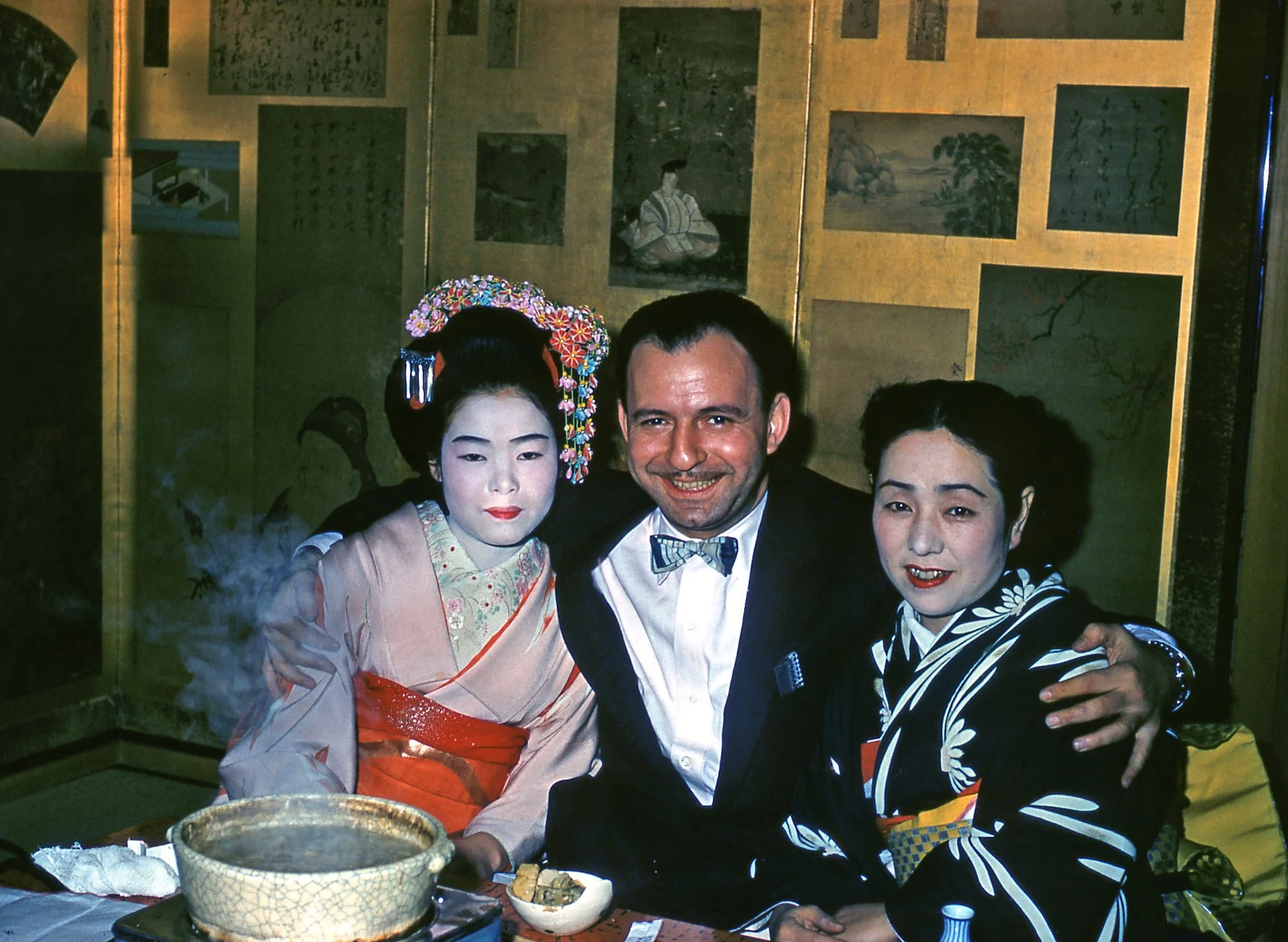Japan’s geisha have survived war and the turn of the century — unruly travelers may be the dying art’s final blow.
A geisha-in-training looks out at Gion, Kyoto. Satoshi-K. CC BY 2.0
With her milky-white oshiroi, silky kimono and glossy bouffant, the geisha’s dramatic flair has left a lasting impression within the cultural imagination of Japan. Geisha, Japanese female entertainers, are regarded as icons of their country’s rich artistic heritage — it’s often said they exist in a sphere separate from the rest of us, in the dreamy, gossamer “flower and willow world.” However, from serving as factory workers during World War II to being popular (and controversial) visitor attractions today, there’s more than meets the eye to these revered performers, and they’ve come a long way from their medieval origins.
“Japanese women in reading and writing” by Katsukawa Shunshō. The New York Public Library. CC0
Sign up for our newsletter here!In Japanese, the word “geisha” literally translates to “art person.” Indeed, traces of the geisha tradition can be traced back as early as Japan’s Heian period in 794, when the country began to place a larger emphasis on poetry and beauty. This newfound appreciation for the fine arts set the aesthetic stage for the geisha’s forerunner, the courtesan, to come onto the scene. Courtesans were female performers well-versed in song, dance, conversation — and sex. Sex work proliferated throughout Japan as men illicitly sought connections outside of their wives, who were still held to Confucian ideals of virtue and modesty. In the 1600s, however, the ruling samurai outlawed prostitution to “clean up” Japanese society, confining sex work to “yūkaku,” or “pleasure houses.” But boxing courtesans out of mainstream society did not kill the industry — rather, consolidating these trained performers gave rise to a new, distinct culture of art and ceremony.
Yūkaku evolved into spaces of entertainment, with women increasingly making their trade in song, dance and music rather than sex. A former prostitute first called herself a “geisha” around 1750, and many women followed suit. It is important to note that although many (both consensually and nonconsensually partook in sexual exchanges, geisha were not sex workers then and are not today. Geisha instead focused on being entertaining hostesses and conversationalists for their upper-echelon clientele and adept in traditional arts like the tea ceremony, calligraphy and flower arranging.
The increasing popularity of geisha persisted well into the 19th century as the profession organized into a highly structured working class involving exclusive apprenticeships and patronages. Training started at a young age, as early as six years old (some children were sold by their parents to geisha houses or “okiya”). Girls spent years as “maiko,” or geisha-in-training, rigorously learning the traditional arts before making their debut. Old-fashioned courtesans declined in popularity as wealthy men increasingly found company in geisha, whose public perception became glamorized as a result. Until World War II.
Sign up for our newsletter here!Like nearly every aspect of Japanese life, the geisha industry was irreversibly changed by WWII. After leaving to aid in the war effort, many “maiko” did not return to their “okiya” after the war, instead choosing to remain in their industrial jobs. With the onset of WWII, becoming a geisha was no longer a girl’s only way out of poverty. Geisha dispersed, and the few that remained grew increasingly protective over their traditions. Some aspects of the trade changed — the training age was raised from six to 16, for example. But this general reclusion from Westernization and modernity contributed to geishas’ decline in the mid-20th century as men shifted their preference to other female entertainers like models and bar girls. But geisha remain popular among travelers, even receiving a popularity boost among Western audiences from Arthur Golding’s (in)famous 1998 novel “Memoirs of a Geisha.”
Two geisha with a businessman. Herb Gouldon. CC0
There are still dozens of geisha districts, or “hanamachi,” across Japan that travelers can visit to experience traditional geisha entertainment and hospitality. In Tokyo, travelers can sample sake and listen to a “samisen” performance, while in Niigata, they can watch “geigi” dancing. But recently, geisha have called out visitors for overstepping boundaries, citing predatory behavior ranging from unsolicited photography to sexual harassment. As a result, Japan’s geisha mecca, Gion, banned non-residents from parts of the region this past March.
Sign up for our newsletter here!“There will be a fine of 10,000 yen [$67 USD]” for nonresidents caught wandering Gion’s streets, Kyoto district official Isokazu Ota told the Associated Press. “Kyoto is not a theme park.”
As COVID precautions have been lifted over recent years, it’s as if people have forgotten how to act now that they can travel again. Several countries have reported instances of traveler misbehavior since easing travel restrictions. Some popular destinations have even implemented tourist bans of their own. However, Japan’s situation is unique as the misbehavior concerning geisha is rooted in a historic misconception laden with sexist undertones.
Geisha are not sex workers. This widespread misunderstanding largely originates from World War II, as men returned home and spoke of their dalliances with “geisha girls.” Given that geisha were and are prohibited from offering sexual services, these men were likely talking about prostitutes and not actual geisha. But by conflating geisha with sex workers, these men began a lasting hypersexualization of geisha, degrading the women and debasing their culture in one fell swoop. Although some geisha did have sexual relationships with their clientele — both by choice and coercion — the misconception that all geisha did so still persists. These lingering sentiments contribute to the harmful thinking and behavior seen today, with visitors believing that it’s okay to treat geisha like zoo animals because they exist to please others, specifically men.
Sign up for our newsletter here!In truth, there has been debate in recent years surrounding the sustainability of Japan’s geisha industry regarding its perceived incompatibility with feminist ideals. Some argue that geisha entertainment is contingent on the male gaze and that its business model is thus outdated and problematic.
“I had clients slip their hands through the side openings of my kimono to fondle my breasts, and when in private rooms they’d open the hems of my kimono so as to touch my crotch. ” ex-geisha Kiritaka Kiyoha wrote on X. “When I told the house mother about these incidents, she directed her anger at me, saying I was at fault.”
When considering their job description at face value, geisha are not inherently feminist. They wear intricate makeup, they learn art and conversation — all to please men. While there may be a self-empowerment aspect to it, they are ultimately catering to and capitalizing off of male interests. But therein lies the paradox: they are capitalizing. Geisha are some of Japan’s most financially independent women. Yes, perhaps this independence wouldn’t be possible without men there to buy their company, but geisha represent a distinctly female tradition of economic self-sufficiency, a feminist ideal some Western countries are still aspiring toward.
Sign up for our newsletter here!Of course, as Kiyoha reminds us, geisha being a time-tested practice doesn’t justify the predatory behavior that props it up: “I would like you to consider if [abuse and harassment] is truly what one would call traditional culture,” she continued on X.
Gion’s traveler restriction is intended to protect geisha and restore dignity to their traditions, but there’s also a fear that it will expedite what many view as the dwindling profession’s inevitable extinction. It’s estimated a mere 1,000 geisha are still practicing in Japan, a far cry from its pre-WWII peak of 80,000. This steady decline, coupled with the bans, leaves many wondering where geisha and their dying art go from here.
“I don’t want the geisha occupation to disappear,” Kiyoha said, but “the industry should rebuild, oriented in a better direction.”
Sign up for our newsletter here!Geisha walks through Kyoto. Tawatchai Prakobkit. CC BY 2.0
Geisha are enigmatic by design, and it is crucial that the public remain interested in the culture and history underlying their time-honored trade. But more than relics of a bygone era, geisha are cultural guardians, and they are people. If/when travel to geisha districts opens back up, it is important to remember that their shroud of mystery is not an invitation for travelers to poke and prod and investigate — there are ways to learn about the culture without violating these women’s boundaries.
Bella Liu
Sign up for our newsletter here!Bella is a student at UC Berkeley studying English, Media Studies and Journalism. When she’s not writing or working through the books on her nightstand, you can find her painting her nails red, taking digicam photos with her friends or yelling at the TV to make the Dodgers play better.





